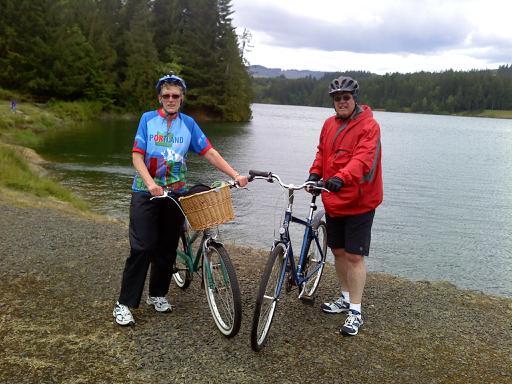









Today we start with a geography lesson. I uploaded a map of our tripk but on my computer it's so small you may not be able to see the arrows indicating our trip progress. We started at Amsterdam, travelling southeast as far as Kinderdijk (windmills), then turned west to den Haag, then north as far as the island of Texel. Now we're on the downside, heading back to Amsterdam tomorrow evening. Right now we're travelling along the side of the Ijsselmeer (Ijssel Lake), which was created in 1932 when the Dutch built a dam across the Zuiderzee (Southern Sea), enclosing the water and turning what was a sea (i.e. ocean access) into a lake (freshwater). This facilitated travel from the eastern states of the NL to the west and also created the possibility of making new land for farming and settlement. After the dam was complete, then they started building dikes to enclose and drain the lakebed, first along the left side and then along the right. Eventually by 1968 there were 5 polders drained from the sea. Today we biked along the dike that encloses the polders on the west side of the Ijsselmeer. The man you see is the stationmaster of the city of Twesk, which contains many lovely historic homes. Although they may look new in my photos, these houses date from the time of the Dutch East India company, as Twesk was once a seaside village home to wealthy sea captains. We stopped by a home undergoing renovations and our guide asked about how the process was going. The home owner, a wealthy businessman, came out and gave us a tour of the place. It's costing him 600,000 euros to redo the outside and roof (about $800,000) and he gets a tax credit for this, since the home is 300 years old and is being renovated to duplicate the historic appearance, including thatched roof.
It will cost him additional funds to do the inside but he won't get tax breaks for that. Since the house cost him only 500,000 euros originally, he's losing money but he doesn't mind, since he wants to live in a historic home in a historic town.
After we left Twesk we cycled along the shore of the Ijsselmeer all the way to Enkhuizen, a former Dutch East India Company town. All along the way we saw modern and historic sailing ships along the Ijsselmeer. It's still quite large and very beautiful. The photos of the two guys wearing aprons are our cook, Simon, and mate, Paddy, serving dinner. They dress up funny with different aprons for different occasions. Paddy's apron has a sheep head covering a sensitive place -- because we were on the island of Texel, where there are more sheep than people. Not quite sure why Simon chose to wear one with women's underwear....
Forgot to mention it above and this program erases forward as you edit, so can't put it back up there, but the reason I took the photo of the stationmaster is that he's wearing klompen (wooden shoes). Farmers still wear them -- it doesn't hurt if a cow steps on your foot, they're not damaged if you walk in a cow pie, you just let it dry and hose it off...
Today we have a shorter bike trip than the 72 km. originally planned, primarily because it's over 90 degrees here and they're worried it will be too strenuous. So the short group (not me) will ride the barge all the way to our next stop, Vollendam, and then do a short 8 km. bike tour to Edam. The longer group (me, not William -- sore knees) will bike the 45 km. distance from here at Enkhuizen to Edam and then on to Vollendam.
See you tomorrow...

No comments:
Post a Comment